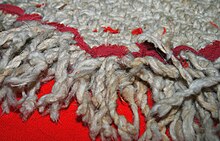Salish weaving
[2] The name Salish refers to groups of indigenous peoples in the Pacific Northwest whose speech and culture share enough of a commonality to suggest an ancient relationship, in a similar vein to the name Indo-Europeans or the name Polynesians.
The region inhabited by this group includes the north of the Fraser canyon to Vancouver Island, to Aberdeen in Washington.
Archaeological excavations done in the area have uncovered extensive amounts of basketry and fibers, revealing which materials were used historically.
The Salish used mountain goat wool, or SAH-ay,[citation needed] as the main source of fiber for weaving.
[5] In addition to collecting mountain goat wool, the Salish kept (mostly white) woolly dogs to use their fur as weaving fibers.
In a 1792 log, Captain George Vancouver wrote that "The dogs belonging to this tribe...were numerous, and resembled those Pomerania, though in general somewhat larger.
They were all shorn as close to the skin as sheep are in England; and so compact were their fleeces, that large portions could be lifted up by a corner without causing any separation.
"[6] The Sto:lo people had dogs similar to a coyote, with a deep, woolly undercoat covered by a coarser long hair.
[5] The Salish had an abundant supply of cedar bark, or SLAH[citation needed] and used it for many things including clothing.
Indian hemp was used by the Salish speaking people near Spuzzum on the Fraser River, as a foundation warp material.
On the grass warp, the blanket of soft dog's hair or mountain goat wool was woven.
[5] Twine made from the bark of nettle stems was used extensively in the manufacture of items requiring strength through a firm, sturdy warp strand.
This bark was then beaten and combed, or carded into a soft tissue which could be spun with the use of a spindle similar to the spinning of wool.
Twine produced from nettle fiber was of great strength and utilized in the making of nets and fishing line, as well as for a warp in weaving.
[5] Twine was made from the bark of the milkweed fiber, a plant indigenous to the Thompson River area.
[5] Sheep's wool, or mah-too-EHL-kel,[citation needed] is the most common material used for modern Salish weaving.
[2] Some red inclusions, found in some blankets, may be made of wool fabric and were used by the Salish weavers in the last quarter of the 1800s.
[citation needed] It is likely that the introduction of these foreign materials into the weaving was based on colour; strips of richly dyed fabric are common in the later plain or solid style Salish blankets while brightly coloured commercial yarns are included in many of the decorative blankets.
In most cases the introduced fabric strips and yarns use colours not available through native plant or mineral dyes.
[2] The Salish loom is formed with two vertical posts that support two horizontal bars about 6 ft in length.
In 1884, a law was passed banning religious practices of the First Nations people as part of an attempt by the colonizers to "civilize" the indigenous population.
As blanket weaving declined, Salish women began to adopt the practice of knitting sweaters and other garments.
These sweaters, known as "Cowichan" after the Vancouver Island Salish community, were made with sheep's wool obtained from the settlers.
The form was the traditional European cardigan sweater, but the designs knitted into the garment were such Salish motifs as eagles and whales.
While these knitted garments did not have the same ceremonial or symbolic importance as the woven blankets, they were nonetheless worn during notable civic and religious events.




